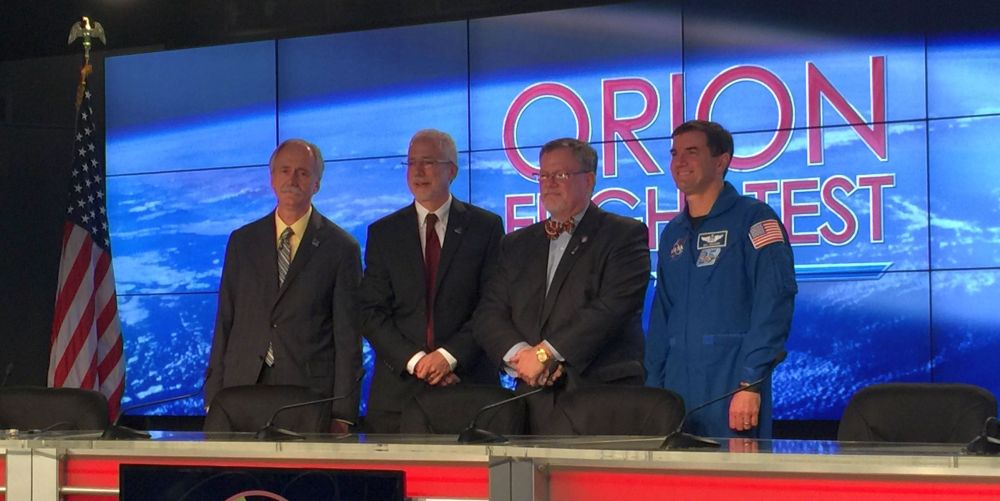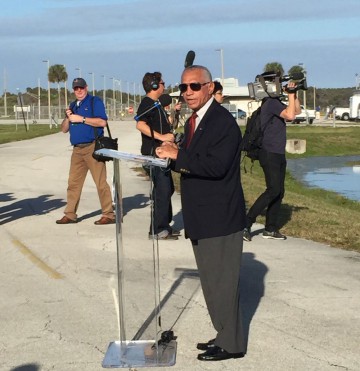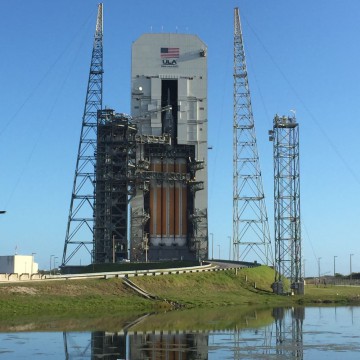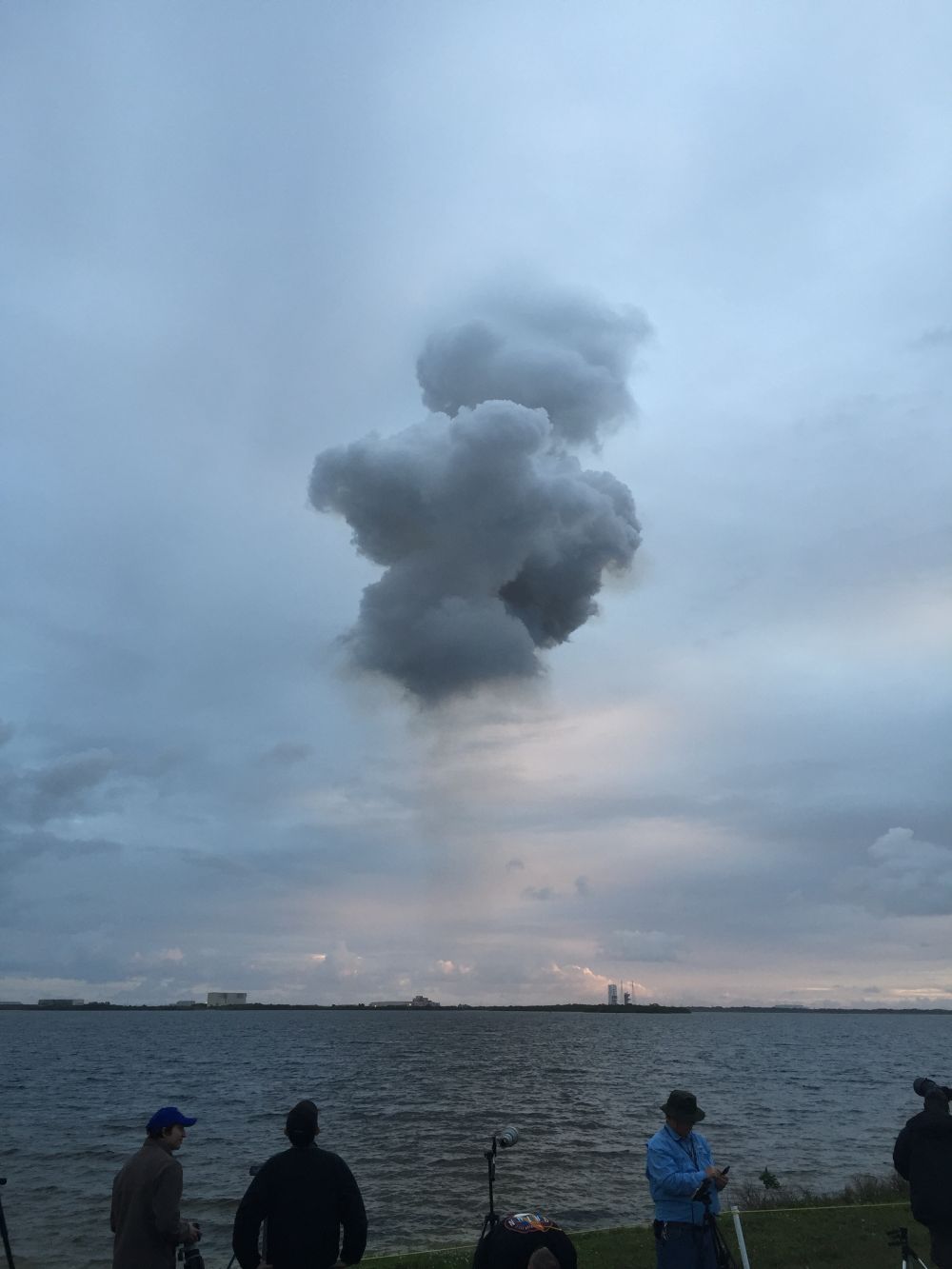
Two days before the launch of EFT-1’s Orion capsule ushered in Cape Canaveral’s second sunrise on the morning of Friday, Dec. 5, four-time shuttle astronaut and NASA Administrator Charles Bolden had some choice words (specifically, a choice acronym) to say about the historic significance of the test flight. During a press availability held at Cape Canaveral Air Force Station’s (CCAFS) Launch Complex 37, Bolden drove his point home.
“I don’t think I need to tell you all, but what you see behind us,” Bolden then motioned to United Launch Alliance’s (ULA) Delta IV Heavy launch vehicle, “is what I call history in the making. Tomorrow is a giant day, a huge day for us. I have become accustomed to calling this a ‘BFD.’ If you don’t know what that is, I’ll let somebody else explain it to you,” he said as the crowd laughed. While the following day’s launch attempt was scrubbed, Bolden’s “BFD” statement set the tone for the events of Dec. 5, when NASA left the shuttle era once and for all by ushering in the dawn of “America’s spacecraft,” meant for deep space treks to asteroids and Mars.

Bolden was joined by fellow shuttle astronauts Bob Cabana (now the director of Kennedy Space Center) and Ellen Ochoa (director of Johnson Space Center). Ochoa added: “People across NASA [and the surrounding community] have contributed to this mission. They understand, that for us, it’s about that next step in pioneering space.”
While NASA’s astronaut administrators stressed EFT-1’s significance as the first step into a pioneering new era of spaceflight, another astronaut discussed the logistics involved in Orion’s proposed human-helmed forays into deep space.
Three-time shuttle veteran Rex Walheim, who is NASA’s astronaut representative to the Orion program, discussed how the agency will help prepare future crews for long-duration asteroid- or Mars-bound missions. In addition, he emphasized how lessons from the shuttle days and ongoing International Space Station (ISS) expeditions will aid in developing these missions. “Obviously, deep space [missions] will be longer than shuttle missions … I imagine, for the first several crews, they will have long-duration experience on the space station. They’ll know from that perspective,” he underscored.
Health effects and servicing equipment are also concerns during long-duration missions, and these points weren’t lost on Walheim. “The first thing is: How does the human body react?” he stated. “We have to understand all the impacts and countermeasures for bone loss. We’re learning that from the space station. The next thing that’s really important – and it’s absolutely critical for the space station to give us some results from it – is how do you have equipment that will actually last for three years? When something breaks on the space station, we just send a new cargo craft up to replace it, and that works just fine [at the present time].

“We have to get to the point where all of our life support systems work perfectly – [where] they do not wear out, or if they do, we have spares that will survive. That is the absolutely critical testbed of the International Space Station: To make sure we understand how systems behave in space, and to make sure we have a set of systems that can work for a three-year mission.”
Walheim also stated that the nature of deep space missions will require a different skill set among the astronaut corps compared to previous programs. “The rest is about training individuals in things they need to know – whether it’s robotics, space walking, or whatever … It will have to be skills-based. Shuttle was task-based. I knew I had to turn this bolt, and attach this piece to the space station. Now, you might not know exactly what you’ll have to do,” he said.
While Orion may not fly as often as shuttle or Apollo, Walheim underscored that each mission will build upon previous flights, providing a succession of major spaceflight milestones. “It’s not going to happen ‘1-2-3.’ It’s going to take time. There’s a constrained budget. We can’t fly like we used to for these deep space missions. We have to keep that in mind. But every so often, there’s going to be a big milestone, and a build on each one. And it’s all going to be very exciting.”
Having flown on STS-135, the final shuttle mission, Walheim can relate to the mixed feelings associated with leaving an orbiter that defined a generation behind. “With STS-135, it was very exciting, but it was excitement tinged with a bit of melancholy. We knew the shuttle program was ending. For the last three-and-a-half years it’s been hard at times – it’s a transitional phase,” he said.
He added: “You can feel the excitement now – this is a new era in spaceflight. If we continue to fulfill our promises and make these vehicles, each one will get better and better. As exciting as the EFT-1 launch will be on top of a Delta IV Heavy, wait until the next one on top of a Space Launch Vehicle. It’s the biggest rocket we’ve had in years since the Saturn V. It’s going to take people’s breaths away… As exciting as it is to fly in low Earth orbit, to have a chance to go to deep space will be really absolutely the ride of a lifetime.”
It has been quoted that each seed from a tree grows into more trees, each standing as a monument to the tree that came before. These astronauts from the shuttle program show that the lessons learned during that era will directly contribute to Orion and, someday, trips to Mars; in addition, they continue to provide the enthusiasm to “keep the dream alive” for newer generations.

Want to keep up-to-date with all things space? Be sure to “Like” AmericaSpace on Facebook and follow us on Twitter: @AmericaSpace




These folks can make their predictions but it remains to be seen if Orion will ever fly again. The history of Presidents making sudden changes did not begin with President Obama though it did usher in a new speed of those changes.
Outstanding work.
The gov’t program that new space trolls bash worked, and the new spacer craft all blow up.
Perfect.